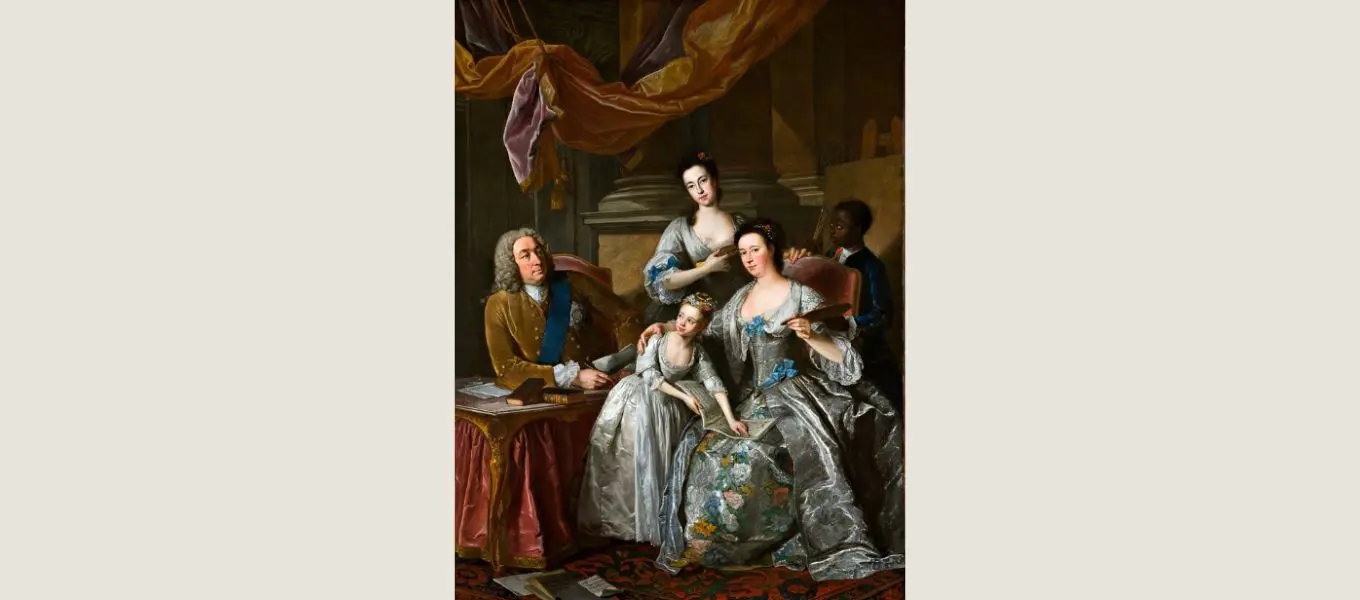
This painting of Richard Boyle, his wife Dorothy Savile and three children by French painter Jean-Baptiste van Loo is critical to understanding the historical representation of the themes of gender, ethnicity and empire explored in the Picturing Childhood exhibition.
Historically, the focus of this painting has been on the man – Richard Boyle – seated on the left, surrounded by books and papers indicative of his interests, namely architecture. He was an architect and the originator of the English Palladian style of architecture and designed his own villa at Chiswick. He was a great patron of the arts, as was his wife Lady Dorothy Boyle (née Savile), seen here, seated.
The portrait represents the whole family as lovers of the arts. The elder daughter Dorothy poses with a finger holding her place in a book; the younger daughter Charlotte points enthusiastically to sheet music open on her mother’s lap.
The music is Handel’s Il Pastor Fido. The Boyles were patrons of Handel’s.
Lady Dorothy Boyle was an artist in her own right and her identity as such is referenced directly in this portrait by the easel and canvas situated behind her and the interaction between her and the child behind her on the right. He is seen either taking or passing a loaded palette of paint from or to her with one hand as he holds her brushes in the other. He seems to be looking at Dorothy, the older daughter. His position in the composition and interaction with mother and daughter suggest a stronger connection to them than to Richard Boyle.
The women in this painting take centre stage and seem to be where our eyes are directed. Certainly, much activity orbits around the figure of Lady Dorothy Boyle. The direction of light draws the eye to the three female figures (look at the triangular formation created by the arrangement of their limbs, position of their skirts and tilts of their head). A triangular compositional base is a device often used by artists in figure compositions.
In addition to her artistic pursuits, Lady Dorothy Boyle was one of the signatories of a petition to King George II asking for the creation of the Foundling Hospital; this was initially unsuccessful and, at a later date, Lady Dorothy persuaded her husband to support the request which was subsequently successful. You can find out more about her here.
The Boyles had three daughters: the eldest (Dorothy) and youngest (Charlotte) are depicted in this portrait. Their middle daughter (Juliana) died as an infant.
Several years after this family portrait was painted, Dorothy (the eldest daughter) married the Earl of Euston. The marriage was short-lived and unhappy – Dorothy died in 1742. The younger daughter, Charlotte, married William Cavendish, Marquess of Hartington (later the 4th Duke). Charlotte had four children but died when she was 23 years old.
We know a lot about the identity and life of the family members however, much less is known about the child of colour, who appears in the painting with them. Research carried out by Richard Hewlings, published in Country Life magazine in 2004, proposed an identity and linked this child to an adult in the employ of the Boyle family in the 1750s, with the name 'James Cambridge'.
Picturing Childhood has been a catalyst for commissioning new research to determine whether there is more historical evidence about his identity and to place this painting within the context of similar representations from the first half of the 18th century.
Learn about our approach to colonialism research.


